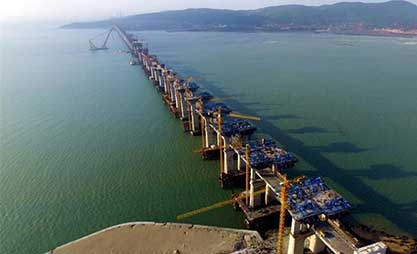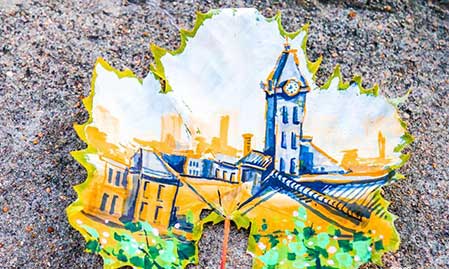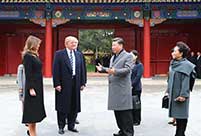

The Fairy Tale of the Five Rams
Like many other renowned cities in the world, the history of Guangzhou (also known as Canton overseas) began with a fairy tale. Legend has it that in ancient times, five celestial beings descended upon this land on the backs of five rams riding on the sea waves. They tossed rice spikes onto the land, chanting in unison: “Let this land be free of famine forever.” This magical land is Guangzhou. Hence, Guangzhou is nicknamed “City of Rams” or “City of Rice Spikes”.
Taoist Temple of Five Celestials. The temple was constructed in 1377 to worship the five celestials who brought harvest to the region. There is a gigantic foot print on the red sandstone at the rear section of the temple, which was said to be the “Toe of the Celestial”.
Founding of Guangzhou
The ancestors of the Cantonese people lived in Guangzhou as early as six or seven thousand years ago, namely, in the Neolithic Age. Nanhai governor Ren Xiao ordered the construction of Panyu City (better known as “Ren Xiao City”) in 214 BC, which is the origin of Guangzhou city as recorded in historical annals. At the turn of the Qin (221BC-206BC) and Han (202BC-220) dynasties, Zhao Tuo founded the Kingdom of Nanyue (also Southern Yue) in Lingnan and made Panyu (present-day Guangzhou) capital of the kingdom. Panyu was also the capital city of the Nanhan (Southern Han, 917-971) and Nanming (Southern Ming, 1644-1662) dynasties. During the Three Kingdoms Period (220-280), the State of Wu “allocated eastern Jiaozhou to set up Guangzhou”, which is the first official appearance of the name “Guangzhou” in historical annals. Modern Guangzhou Municipality was founded on Feb. 15, 1921. Up to now, the city of Guangzhou has been established for more than 2,200 years.
Millennium Trade Capital
For more than two thousand years, Guangzhou has always been a major port for China’s foreign trade. During the reign of Emperor Wudi of the Han Dynasty (202BC-220AD), a Chinese fleet set sail from Guangzhou and visited Southeast Asia and South Asia for trading. During the Eastern Han Dynasty (25-220AD), the sea route was extended as far as the Persian Gulf. By the Tang Dynasty (618-907), Guangzhou had become one of the biggest ports in the East and the starting point of the world’s longest shipping route, known as “Guangzhou Foreign Sea Route”. During the Song Dynasty (960-1279), Shibosi, China’s first foreign trade management office, was set up in Guangzhou. In the 13th Century, the city had foreign trade relations with over 140 countries and regions. Later, in the Ming (1368-1644) and Qing (1644-1911) dynasties, Guangzhou was a specially-opened port, and for a considerable length of time, the city was China’s only port for foreign trade.
An Epic City
Guangzhou is an epic city with glorious revolutionary traditions. In Guangzhou’s pre-modern history, people at Sanyuanli rose up to fight against British invaders while Sun Yat-sen engineered the March 29 Uprising against the feudal rule in 1911, and the Communist Party of China launched the Guangzhou Uprising in 1927. In a word, Guangzhou is not only the cradle of the democratic revolution of the Chinese bourgeoisie but also a heroic city where proletarian party leaders led the people to hold various revolutionary activities.
Residence of Hong Xiuquan. Hong Xiuquan, an eminent peasant movement leader, led the anti-imperialist and anti-feudal “Taiping Heavenly Kingdom” peasant movement during the Chinese pre-modern period.
Historical Sites
Guangzhou, a renowned Chinese historical and cultural city boasting over 2,200 years of history, was the capital of three ancient dynasties – Nanyue (203BC-111BC), Nanhan (917-971) and Nanming (1644-1662). There are numerous historical and cultural relics scattering in Guangzhou, vividly reflecting the city’s development through different historical stages.
The city is home to 424 cultural relics protected at the national, provincial and municipal levels. The Western Han Dynasty Mausoleum of the Nanyue King, the Guangxiao Temple, the Temple of Six Banyan Trees and the Huaisheng Mosque are all more than one thousand years old. Other major relics include the Nanhai God (South Sea God) Temple first built during the Sui Dynasty (581-618), the Taoist Temple of Five Celestials, the Zhenhai Tower and the Lotus Pagoda Temple from the Ming Dynasty, as well as the Chen Clan Academy and the Yu Yam Villa from the Qing Dynasty. Main pre-modern revolutionary sites include the Institute of Peasant Movement inaugurated by Comrade Mao Zedong, the Cemetery of Guangzhou Uprising Martyrs, the Huanghuagang Mausoleum of 72 Martyrs, the Former Site of the Huangpu Military Academy (also known as Whampoa Military Academy), Sun Yat-sen Memorial Hall and the Residence of Hong Xiuquan, etc.
 Chinese brand becomes largest handset provider in Africa
Chinese brand becomes largest handset provider in Africa Busty Lais Ribeiro steals the Victoria's Secret Fashion Show
Busty Lais Ribeiro steals the Victoria's Secret Fashion Show Highlights Victoria's Secret Fashion Show in Shanghai
Highlights Victoria's Secret Fashion Show in Shanghai China's first cross-sea rail-road bridge takes shape
China's first cross-sea rail-road bridge takes shape A fancy world painted on fallen leaves
A fancy world painted on fallen leaves Photo album: Xi-Trump meeting in Beijing
Photo album: Xi-Trump meeting in Beijing Pitaya flower: blooms for one night, yields delicious fruit
Pitaya flower: blooms for one night, yields delicious fruit Hol Xil: Ideal habitat for Tibetan animals
Hol Xil: Ideal habitat for Tibetan animals Skywalk made of glass opens in Guizhou's Yuntaishan
Skywalk made of glass opens in Guizhou's Yuntaishan Top 10 most sustainable cities in China
Top 10 most sustainable cities in China Top 10 European patent applicants in 2016
Top 10 European patent applicants in 2016 The power of 'She' in China
The power of 'She' in China Seven most beautiful art museums in China
Seven most beautiful art museums in China Cyber rumors must be effectively addressed
Cyber rumors must be effectively addressed
 Migrant workers leave Beijing in droves amid evictions enacted following deadly fire
Migrant workers leave Beijing in droves amid evictions enacted following deadly fire
 Profits before pupils
Profits before pupils
 Is Weibo still the best choice for young Chinese when it comes to social media platforms?
Is Weibo still the best choice for young Chinese when it comes to social media platforms?
Day|Week